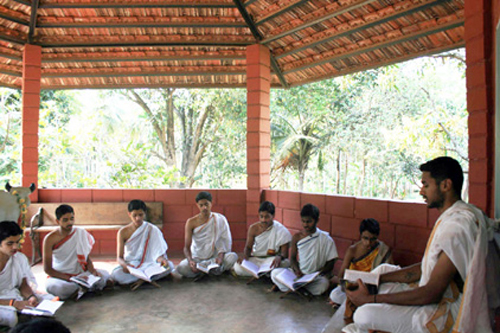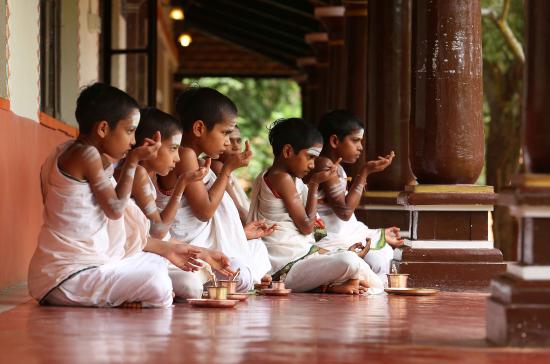Innovation and creativity thrive on thinking without boundaries. Unfortunately our current education system focuses on Taught concept rather than Thought concept. After the 18th century, if one observes, India’s contribution to science and culture has gradually declined. It is surprising that a country like India which is one of the ancient nations in culture and civilization when majority of the rest of the world was still in nomadic stages, of late is mostly boasting on the past laurels. If one analyses critically, one can find that the main reason for this decline lies in India’s education system.
In the ancient India we had Gurukulam system of education. It was a residential education system where the children used to stay away from their parents and families. The guru not only used to impart knowledge to the students but mainly created an environment wherein the students were gradually exposed to the outside world and its realities. Our ancient education system emphasized on learning concept  rather than teaching concept. Though the students were taught the Vedas through recital or chanting the slokas, through Upanishads the students were introduced to the concept of learning. Learning basically thrives on inquisitiveness. An inquisitive approach is possible only through the following process- Enquire, Explore, Experiment and Evaluate.
rather than teaching concept. Though the students were taught the Vedas through recital or chanting the slokas, through Upanishads the students were introduced to the concept of learning. Learning basically thrives on inquisitiveness. An inquisitive approach is possible only through the following process- Enquire, Explore, Experiment and Evaluate.
Enquiry enables a person to start raising questions like- What, Why, When, Who, Where…., and find answers to his questions. An enquiring mind is the base for rational thinking. Deeper level of enquiry leads to Exploring and thereafter to Experimenting. Experimenting is the real self learning process and an analysis of the outcomes of such self experiment leads to Evaluation. Therefore, rational thinking and analytical approach can be cultivated if one follows the steps- Enquire, Explore, Experiment and Evaluate. In fact this is the essence of scientific temperament.
In the Gurukula concept the disciples were also primarily trained on how to preserve the nature and its resources through a sustainable living in order to leave a better planet for the future generations. That is why nature, understanding preserving and worshipping the nature are integral parts of our Vedic school of education. Living in harmony with the nature is the essence of all rituals of our Vedic school of thought. Simple living by economic use of the nature and its resources is the heart of our Hindu philosophy. The disciples were trained in not only to become efficient and effective in their daily activities but more importantly on economic usage of the material things in life. These three principles of Economy, Efficiency and Effectiveness made the disciples more pragmatic in their daily lives.
When the body, mind and the soul are in sync and work in the same direction a person’s approach becomes very passionate. Our ancient Rishis and saints had fully understood the importance of harmony of body, mind and soul. When one is passionate and patiently pursues his efforts with perseverance he achieves success in his endeavours. If one observes the epic characters like Rama in Ramayana and Arjuna in Maha Bharatha , the key behind their success in becoming great warriors and leaders can be attributed to the qualities they followed like Passion, Patience and Perseverance. While passion gives happiness in what we pursue to achieve, patience and perseverance contribute to success. Success with happiness leads to excellence. While, physical health is associated with one’s body, psychological health and spiritual health are associated with mind and soul respectively. Our ancient sages were fully aware of this and emphasized on a balanced way of living through integration of body, mind and soul. Practice of our Vedic school of thought makes a person to become a complete human being through this balanced way of living mentioned above.
Therefore, our Vedic school of education is a rare and unique one which imparts scientific temperament (Enquire, Explore, Experiment and Evaluate), gives training on how to live in harmony with the nature in a pragmatic way (Economy, Efficiency and Effectiveness) and how to achieve success with happiness (Passion, Patience and Perseverance).
All the four Vedas preach a Mahavaakya (great statement) –
“ Prajnaanam Bhrhma”( Pure consciousness is the highest truth) says Aitareya Upanishad 3.3 of the Rig Veda.
“ Aham Brahmasmi” ( I am the divine) says Brhadaranyaka Upanishad 1.4.10 of Yajur veda.
“ Tat Tatvam Asmi “ ( Thou art That ) says Chandyogya Upanishad 6.8.7. of the Sama Veda.
“ Ayam Atma Brahma”( This self is The Absolute) says Mandukya Upanishad 1.2 of the Atharva Veda.
Upa means nearest (self) and ni means definiteness that which is well ascertained (Knowledge)–sat or sad means enduring, or everlasting (Truth). The knowledge that leads to realization of the self is the eternal truth. Upanishad also means Upa (near) ni (down) sad (sit), ie., to sit down near. The disciple is imparted knowledge by guru through discourse in Upanishads, where the disciples sit near the guru. Listening or Sravana plays a crucial role for the disciple in seeking the knowledge from the guru in Upanishads. Whereas, Brahma Sutras enable a person to understand the essence of the knowledge so obtained through Upanishads by rational thinking. Therefore, application of thought is the key to comprehend the essence of Brahma Sutras. Study of Bhagavad Geeta enables a person to practice (sadhana) the knowledge (so gained from  Upanishads and Brahma Sutras) in daily life (Nidhi Dhyasa). The essence of Hinduism is contained in Upanishads, Brahma Sutras and Bhagavad Geeta,collectively known as Prasthana Trayi. The holistic approach adopted by our Prasthana Trayi makes a person to understand the laws of Universe preserve and live in harmony with the nature and realize the eternal truth by self knowledge. In other words the emphasis is on self knowledge or thought concept.
Upanishads and Brahma Sutras) in daily life (Nidhi Dhyasa). The essence of Hinduism is contained in Upanishads, Brahma Sutras and Bhagavad Geeta,collectively known as Prasthana Trayi. The holistic approach adopted by our Prasthana Trayi makes a person to understand the laws of Universe preserve and live in harmony with the nature and realize the eternal truth by self knowledge. In other words the emphasis is on self knowledge or thought concept.
Contrary to the above, the British model of education that we are currently following since late 18th century and early 19th century shifted the emphasis from thought concept (learning) to taught concept (teaching). This has greatly succeeded in training the people to become government employees of the British regime, more particularly by removing the language barrier through introduction of English language as a medium of communication in education. In the process we Indians have completely lost touch with the mother of all our Indian languages, Sanskrit. As the Vedic literature is written in Sanskrit the British education system has completely delinked us from our roots, Sanskrit language. This has created a big cultural gap wherein we lost our original thinking and identity and have simply become carbon copies of a foreign culture, becoming a mere shadow. One should be open to new ideas and new thoughts and therefore should be a part of globalization. A the same time it is equally important to retain one’s own uniqueness and identity through adherence to one’s culture and traditions(dharma) because culture and traditions are aligned with the geographical and ecological factors that are not only unique to one’s place of living but quite different from other cultures and traditions. Each country’s culture and traditions are therefore not only unique to their respective countries but would probably be distinct and sound alien in the context of other countries of the world.
Shreyan swa-dharmo vigunaha par-dharmat swanusthitat,
Swadharme nidhanam shreyaha par- dharmo bhayavaha. ( 3.35 Bhagavad geeta)
To do one’s own duty (dharma) is good even if it is very small or insignificant. It is commendable even if one dies while doing his duty. One should not attempt to do or imitate others duties because it can be even dangerous to do so. The duty of each person is based on the position or responsibility held by him as well as the nature of the situation and the local environmental and geological conditions. Therefore, attempting to do or imitating others duties (dharma) will many times be even disastrous since it may not align with the local environmental and geological conditions. Blindly aping the British model of education (even after we got freedom from the British rule in 1947) has only led to continuation of the taught concept and abdication of the thought concept in our education model (particularly at the primary and middle level education). It is neither practical nor pragmatic to completely discard the current education model in spite of its shortcomings.
However, what we can do is to reintroduce the Vedic concept of education at the primary and middle level along with the current education model with suitable modifications to reconnect with our roots and at the same time meeting the requirements of thinking globally and acting locally, which is the need of the hour.
~ B.N.V.Parthasarathi, Ex- Vice President and Branch Head, Bank of Bahrain and Kuwait, Hyderabad. Photo credit: Art of Living Ved Patshala, Bengaluru.











